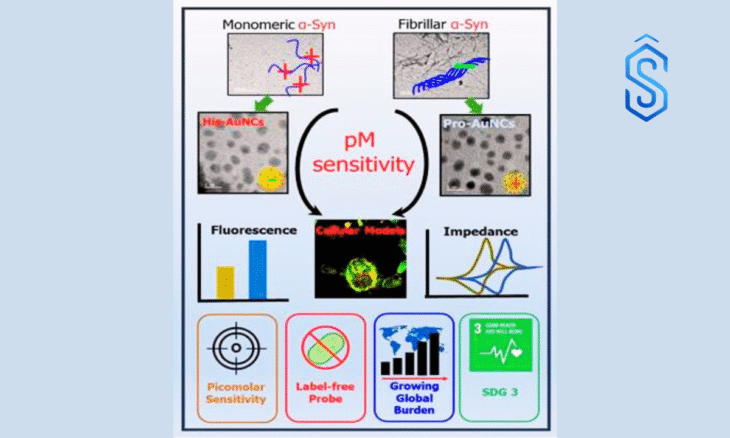New Delhi: In a pioneering development, researchers at the Institute of Nano Science and Technology (INST), Mohali, have demonstrated that gold nanoclusters (AuNCs) could be the key to creating a nanotechnology-based biosensor for the early detection of Parkinson’s disease (PD).
Parkinson’s disease is among the fastest-growing neurological disorders worldwide, with cases in India projected to rise sharply due to increasing life expectancy. At present, most diagnoses occur only after substantial neurodegeneration has taken place.
Also Read: Smart Nano-Materials Enable Ultra-Sensitive Detection of Explosives like TNT and RDX
Gold Nanoclusters: A Breakthrough Tool Against Parkinson’s
The INST research team has developed a proof-of-concept technology using gold nanoclusters that can detect dangerous protein formations linked to Parkinson’s at a much earlier stage.
The study focused on α-synuclein, a brain protein associated with PD. Normally harmless, α-synuclein can clump into toxic aggregates that damage neurons. To differentiate between these forms, the researchers coated gold nanoclusters with amino acids, giving them selective binding properties.
Proline-coated clusters adhered to normal proteins, while histidine-coated clusters targeted the toxic aggregates—allowing clear distinction between safe and harmful protein structures.
Advanced Nano-Biosensing Techniques
The research involved extensive experiments, including protein purification, synthesis of amino acid–capped gold nanoclusters, and detailed characterization using UV-Vis spectroscopy, fluorescence imaging, TEM, and XPS.
Also Read: Atmospheric Chemistry Laboratory Inaugurated at IITM Pune
Electrochemical techniques such as cyclic voltammetry and impedance spectroscopy were used to measure the sensitivity of the interactions. The system was also validated in human-derived SH-SY5Y neuroblastoma cells, confirming both safety and effectiveness under biological conditions.
Collaborative Research Effort
The project was led by Dr Sharmistha Sinha, Senior Scientist at INST, with PhD students Harpreet Kaur and Ishani Sharma, in collaboration with Dr Deepak Sharma and Arpit Tyagi at the CSIR-Institute of Microbial Technology (IMTECH), Chandigarh. Their joint expertise in nanotechnology, protein biochemistry, and cell-based assays transformed a lab discussion into a validated biosensing platform.
Implications Beyond Parkinson’s
A diagnostic tool based on gold nanoclusters could enable detection of Parkinson’s disease before symptoms appear, improving treatment outcomes, reducing healthcare costs, and enhancing quality of life. The technology may also be adapted to detect other protein misfolding disorders such as Alzheimer’s disease.
The system is label-free, low-cost, and adaptable for clinical use, making it a strong candidate for future point-of-care diagnostics. By bringing powerful diagnostic tools closer to patients, it supports global efforts to address neurological diseases.
The findings have been accepted for publication in Nanoscale (Royal Society of Chemistry).





